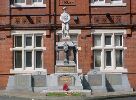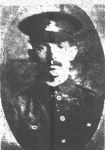
Newton-le-Willows and
Earlestown War Memorial

| OTHER WARS |
 |
Newton-le-Willows andEarlestown War Memorial |
 |
| The
Great War Roll of Honour |
|||||||||||||||||||||||||

The Newton and Earlestown Guardian of 4th August 1916 recorded
the fact that Private John Wm. Riding was missing following "an engagement
in France on July 1st." Private Riding was 33 years old and lived at
27, Cherry Street, Earlestown, with his wife, Dora,
and their three children, Albert, Sam and Doris, although he was born in Condon,
Durham according to "Soldiers Died in the Great War". He worked
as a collier at Old Boston for eleven years.
An 'In Memoriam' advertisement for Jack was
place in the Guardian on July 5th 1918 from "his sisters and brothers
Maggie, Lizzie, Lilly, Sam, Bob and Bill in Newton and Haydock."
Both the Commonwealth War Graves Commission and "Soldiers Died in the
Great War" have him as Ridings, with an 's'. However, neither the obituary
nor the In Memoriam have an 's'.
He enlisted in 1915 in Kitchener's Army and saw service in the Dardanelles,
the battalion landing at Gallipoli on the 25th April. The Guardian's obituary
refers to Jack as having enlisted "12 months ago", i.e. in the summer
of 1915, so he may or may not have been involved in the "Lancashire
Landing". They left there for Egypt on 2nd January 1916. They landed
in Marseilles on the way to the Western Front on 29th March 1916.
Pte. Riding was killed on the first day of the offensive known as the Battle
of the Somme. The 1st Battalion of the Lancashire Fusiliers was part of the
86th Brigade of the 29th Division, the same division as Walter Entwistle who
was also killed on 1st July 1916. Jack is buried in Grave
A 59 in Beaumont Hamel
British Cemetery, which is about 10 kilometres north of Albert.
"The Official History of the Great War" describes the action which
involved Jack Riding:
"The preparations on the front of the 29th Division included the excavation
of three shallow tunnels under No Man's Land: one to be opened up as a communication
trench to the sunken lane, and the others dug to within thirty yards of the
German front trench. The extremities of the latter two, at 2 a.m. on the morning
of the assault, were opened up to the surface as emplacements for batteries
of Stokes mortars.
"The assault of the 86th Brigade which was to carry the village of Beaumont
Hamel, hidden in the bed of the valley, fared no better [than the 87th Brigade],
fire being opened as soon as the men left the trenches five minutes before
zero. The 2/Royal Fusiliers, on the right, suffered very heavy casualties…
The attack of the 1/Lancashire Fusiliers, on the left, was led by two companies
(with a special bombing party one hundred strong, two machine guns and four
Stokes mortars) which had gone forward by the sap to the sunken lane half-way
across No Man's Land. Although supported by a simultaneous attack of the rest
of the battalion from the British front trench, their attack, as a whole,
failed not many yards from the sunken lane: in fact the Lancashire men were
mown down directly they showed above the dip in which the lane lies, and only
a party of about fifty reached the low bank beyond it… Except for some
120 of the 2/Royal Fusiliers who made their way to the Hawthorn mine crater,
none of the 86th Brigade reached the German position.
"Following the Gallipoli practice, all the infantrymen of the 29th Division,
in order to assist the artillery in spotting the front line, wore a triangle
cut from biscuit tin, which was sewn on the haversack, carried on the back.
With the sun's rays shining, the plaque certainly showed up the position of
the men lying on the ground, but as it was thought to have increased the casualties,
it was never worn again."